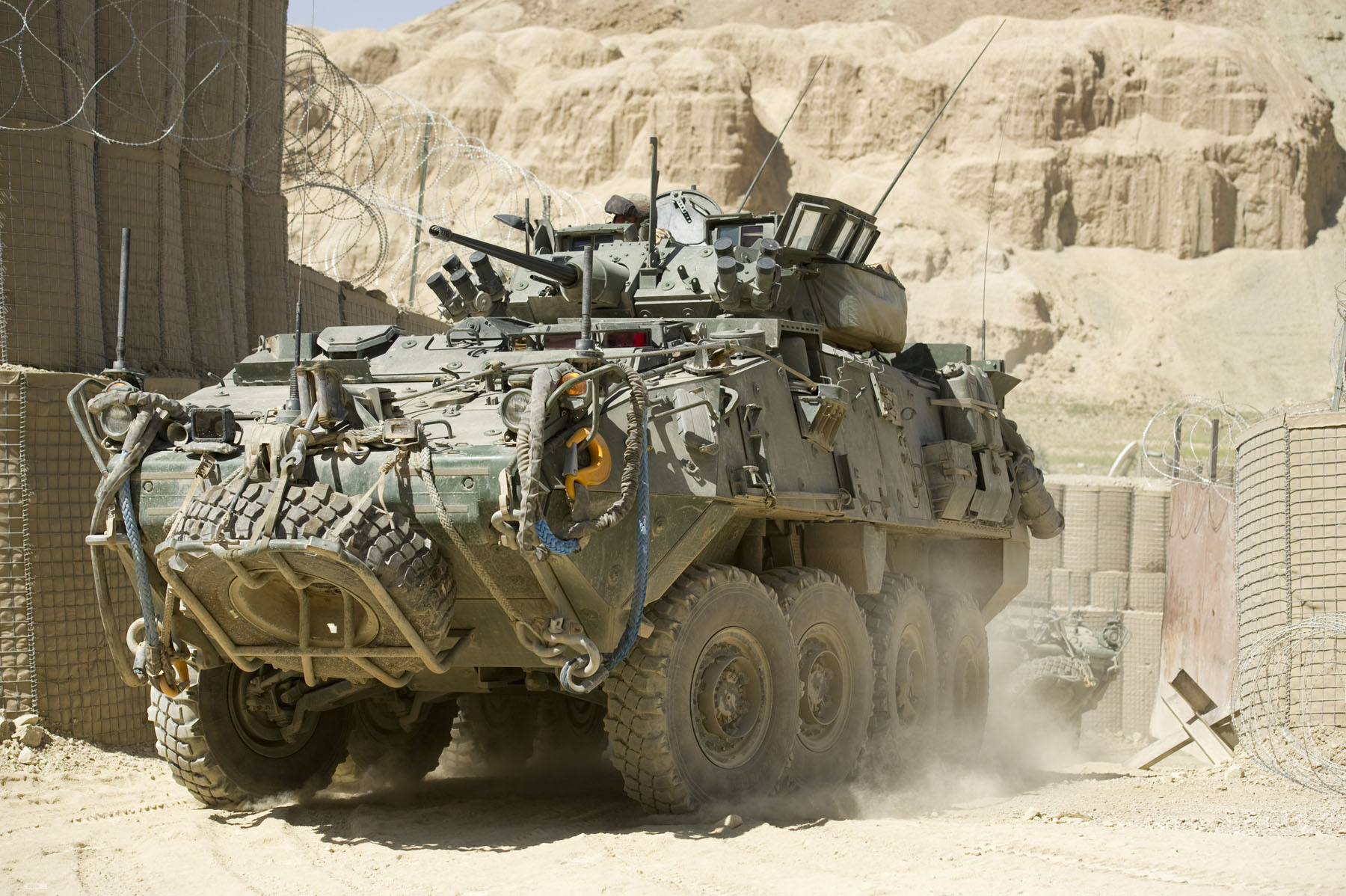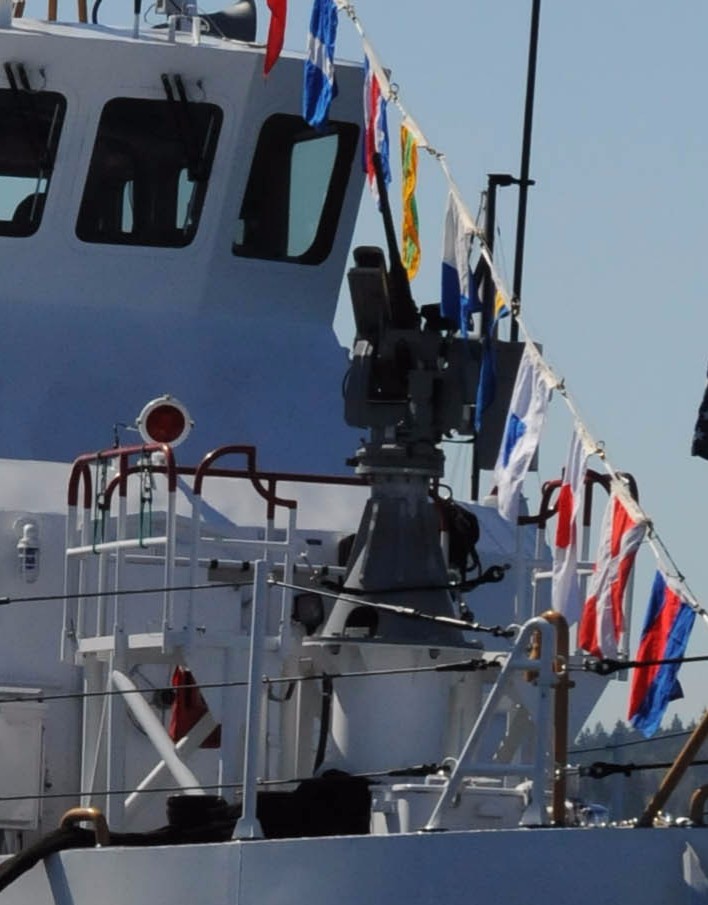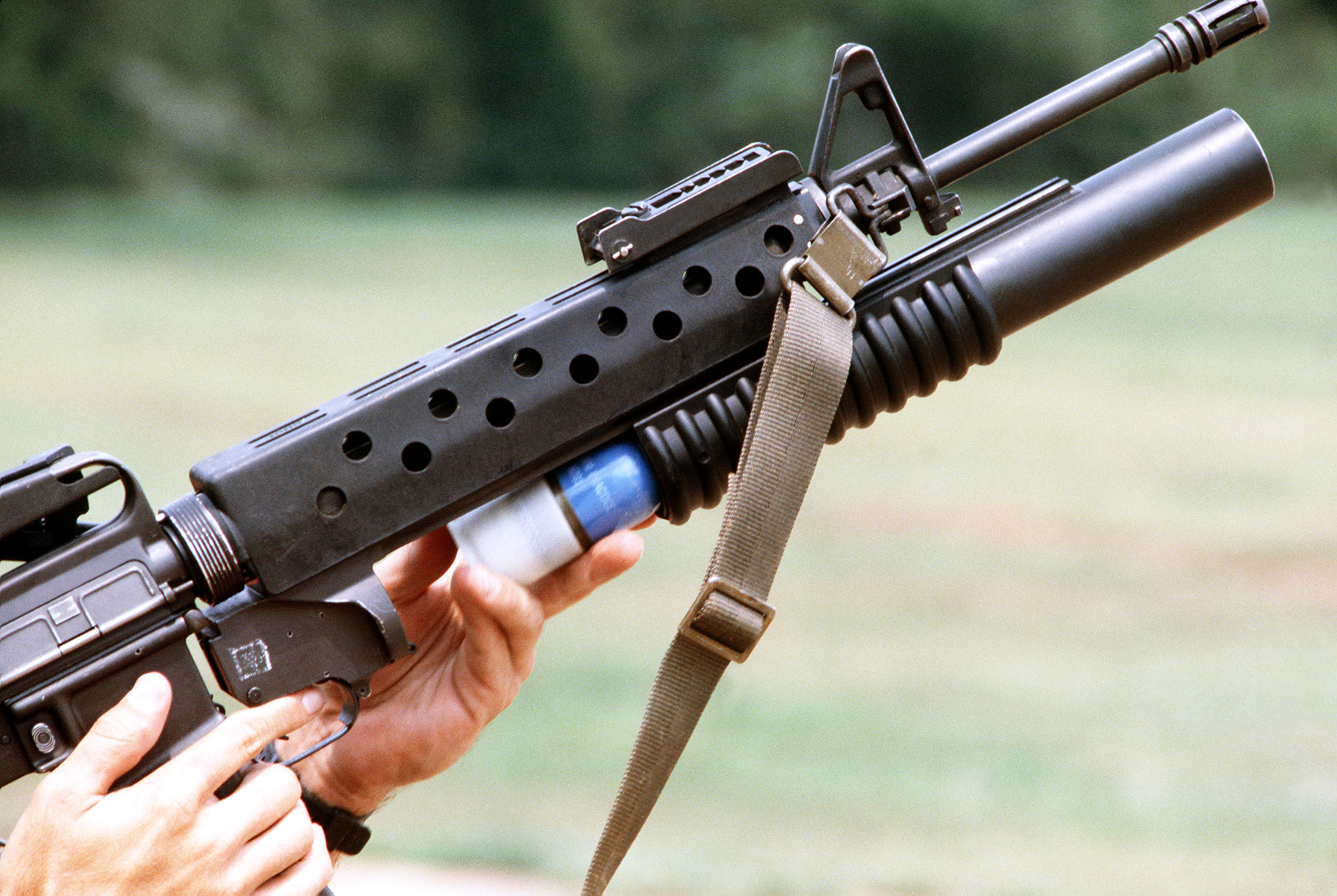|
M1126
The M1126 Infantry Carrier Vehicle (ICV) is an armored personnel carrier and part of the Stryker family of vehicles (derived from the Canadian LAV III/Swiss MOWAG Piranha IIIH 8x8) used by the United States Army and Royal Thai Army. Models with the double V-hull upgrade are known as the M1256 ICVV. General The Infantry Carrier Vehicle provides protected transport and, during dismounted assault, supporting fire for the infantry squad. The Stryker is a full-time four-wheel drive, selectively eight-wheel drive, armored vehicle weighing approximately 19t which carries an infantry squad with their equipment. On paved roads the vehicle can attain speeds of without a governor and with a governor. The basic infantry carrier vehicle (ICV) provides armored protection for the two-man crew and a squad of nine soldiers. Digital communications system The vehicle's commander has a Force XXI Battle Command Brigade and Below (FBCB2) digital communications system that allows communicatio ... [...More Info...] [...Related Items...] OR: [Wikipedia] [Google] [Baidu] |
Stryker
The Stryker is a family of eight-wheeled armored fighting vehicles derived from the Canadian LAV III. Stryker vehicles are produced by General Dynamics Land Systems-Canada (GDLS-C) for the United States Army in a plant in London, Ontario. It has four-wheel drive (8×4) and can be switched to all-wheel drive (8×8). The Stryker was conceived as a family of vehicles forming the backbone of a new medium-weight brigade combat team (BCT) that was to strike a balance between heavy armor and infantry. The service launched the Interim Armored Vehicle competition, and in 2000, the service selected the LAV III proposed by GDLS and General Motors Defense. The service named this family of vehicles the "Stryker". Ten variants of the Stryker were initially conceived, some of which have been upgraded with v-hulls. Development history Interim Armored Vehicle competition In October 1999, General Eric Shinseki, then U.S. Army Chief of Staff, outlined a transformation plan for the Army tha ... [...More Info...] [...Related Items...] OR: [Wikipedia] [Google] [Baidu] |
GCV Infantry Fighting Vehicle
The Ground Combat Vehicle (GCV) was the United States Army's replacement program for armored fighting vehicles in Armored and Stryker brigade combat teams. The GCV was organized under the ''Follow On Incremental Capabilities Package'' of the BCT Modernization program. The first variant of the vehicle was to be prototyped in 2015 and fielded by 2017. It replaced the canceled Future Combat Systems, manned ground vehicles program. The GCV program was cancelled in February 2014. Its replacement was the Optionally Manned Fighting Vehicle.US Army, Marines Struggle With Infantry Vehicle Replacements - Defensenews.com, 6 April 2014 Design Spe ...[...More Info...] [...Related Items...] OR: [Wikipedia] [Google] [Baidu] |
Squad
In military terminology, a squad is among the smallest of military organizations and is led by a non-commissioned officer. NATO and US doctrine define a squad as an organization "larger than a team, but smaller than a section." while US Army doctrine further defines a squad as a "small military unit typically containing two or more fire teams." In US usage, a squad consists of eight to fourteen soldiers, and may be further subdivided into fireteams. Organization NATO The standard NATO symbol for a ''squad'' consists of one single dot (●) placed above a framed unit icon. United States United States Army Historically, a "squad" in the US Army was a sub-unit of a section, consisting of from as few as two soldiers to as many as 12 and was originally used primarily for drill and administrative purposes (e.g., billeting, messing, working parties, etc.). The smallest tactical sub-unit being the section, which was also known as a half-platoon (the platoon itself being a half com ... [...More Info...] [...Related Items...] OR: [Wikipedia] [Google] [Baidu] |
LAV III
The LAV III, originally named the Kodiak by the Canadian Army, is the third generation of the LAV (Canada), Light Armoured Vehicle (LAV) family of armored personnel carriers built by General Dynamics Land Systems – Canada (GDLS-C), a London, Ontario, based subsidiary of General Dynamics Land Systems, General Dynamics. It first entered service in 1999, succeeding the LAV II. It is the primary mechanized infantry vehicle of both the Canadian Army and the New Zealand Army. It also forms the basis of the Stryker vehicle used by the U.S. Army and other operators. The Canadian Army is upgrading its LAV IIIs to the LAV 6 standard. Development By July 1991, the Canadian Army, Canadian Armed Forces had identified the need to replace their aging fleet of 1960s and 1970s era armoured personnel carriers. As a result, $2.8 billion was earmarked for the TH-495, Multi-Role Combat Vehicle (MRCV) project by the sitting Progressive Conservative Party of Canada, Conservative government. The manda ... [...More Info...] [...Related Items...] OR: [Wikipedia] [Google] [Baidu] |
Mk44 Bushmaster II
The Mk44 Bushmaster II is a 30 mm chain gun manufactured by Northrop Grumman. It is a derivative of the 25 mm M242 Bushmaster, and uses 70% of the same parts as the M242 while increasing the firepower by as much as 50% with the 20% increase in caliber size. The barrel is chromium-plated for extended life. The gun uses standard GAU-8 Avenger ammunition that is available in API (Armor-Piercing Incendiary), HEI (High-Explosive Incendiary) and APFSDS-T (Armor-Piercing Fin-Stabilized Discarding Sabot-Tracer) variants. The gun can be converted to a caliber of 40x180 mm, which involves changing the barrel and a few key parts, to use the SuperShot 40 cartridge. It can also be converted to use the 30x170 mm RARDEN cartridge. History The Bushmaster II is the standard primary armament of the Bionix-II AFV currently in service with the Singapore Army, the KTO Rosomak in Polish service, and the CV90 AFVs in Finnish, Norwegian and Swiss service. Although the United States Air ... [...More Info...] [...Related Items...] OR: [Wikipedia] [Google] [Baidu] |
Protector (RWS)
The Protector RWS is a remotely controlled weapons station (RWS) that can be mounted to vehicles and stationary platforms. It has been in full scale production since December 2001. It is manufactured by Kongsberg Defence & Aerospace of Norway. Design The system consists of a stabilized firing platform, a fire-control system and control grips. Several weapons can be mounted to the platform, such as: * M2 Browning 12.7x99 .50 BMG heavy machine gun * NSV 12.7x108 heavy machine gun * M240/FN MAG 7.62×51mm NATO general-purpose machine gun * M249/FN Minimi 5.56×45mm NATO light machine gun * MK19 40×53 mm automatic grenade launcher * H&K GMG 40×53 mm automatic grenade launcher * XM307 Advanced Crew Served Weapon * Javelin anti-tank guided missile * Hellfire anti-tank guided missile (from a modified Protector) Versions Several versions of Protector have been developed with more than 20,000 units sold around the world in service with 23 countries. Between the M151 and M ... [...More Info...] [...Related Items...] OR: [Wikipedia] [Google] [Baidu] |
M2 Bradley
The M2 Bradley, or Bradley IFV, is an American infantry fighting vehicle that is a member of the Bradley Fighting Vehicle family. It is manufactured by BAE Systems Land & Armaments, which was formerly United Defense. The Bradley is designed for reconnaissance and to transport a squad of infantry, providing them protection from small arms fire, while also providing firepower to both suppress and eliminate most threats to friendly infantry. It is designed to be highly maneuverable and to be fast enough to keep up with heavy armor during an advance. The M2 holds a crew of three: a commander, a gunner, and a driver, as well as six fully equipped soldiers as passengers. In the year 2000 the total cost of the program was $5,664,100,000 for 1,602 units, giving an average unit cost of $3,166,000, or $5,500,000 per in 2022. Design The Bradley IFV was developed largely in response to the amphibious Soviet BMP family of infantry fighting vehicles, and to serve as both an armored perso ... [...More Info...] [...Related Items...] OR: [Wikipedia] [Google] [Baidu] |
Infantry
Infantry is a military specialization which engages in ground combat on foot. Infantry generally consists of light infantry, mountain infantry, motorized infantry & mechanized infantry, airborne infantry, air assault infantry, and marine infantry. Although disused in modern times, heavy infantry also commonly made up the bulk of many historic armies. Infantry, cavalry, and artillery have traditionally made up the core of the combat arms professions of various armies, with the infantry almost always comprising the largest portion of these forces. Etymology and terminology In English, use of the term ''infantry'' began about the 1570s, describing soldiers who march and fight on foot. The word derives from Middle French ''infanterie'', from older Italian (also Spanish) ''infanteria'' (foot soldiers too inexperienced for cavalry), from Latin '' īnfāns'' (without speech, newborn, foolish), from which English also gets '' infant''. The individual-soldier term ''infantry ... [...More Info...] [...Related Items...] OR: [Wikipedia] [Google] [Baidu] |
Force XXI Battle Command Brigade And Below
Force XXI Battle Command Brigade and Below (FBCB2) is a Linux (operating system), Linux-based communication platform designed for commanders to track friendly and hostile forces on the battlefield. It increases a vehicle commander's situational awareness of the battlefield by gathering information near real-time based on vehicle locations being updated on the battlefield. This information is viewed graphically, and exchanged via both free and fixed text message formats (instead of verbal collection of reports). The location data for friendly forces is collected through the Enhanced Position Location Reporting System (EPLRS) line of sight tactical radio network and Blue Force Tracking (BFT) satellite network. Development The development of the system is managed by Project Manager, Force XXI Battle Command Brigade and Below, a component of the U.S. Army's Program Executive Office – Command Control and Communications Tactical (PEO C3T). PEO C3T is based at Aberdeen Proving Gro ... [...More Info...] [...Related Items...] OR: [Wikipedia] [Google] [Baidu] |
50 BMG
The .50 Browning Machine Gun (.50 BMG, 12.7×99mm NATO and designated as the 50 Browning by the C.I.P.) is a caliber cartridge developed for the M2 Browning heavy machine gun in the late 1910s, entering official service in 1921. Under STANAG 4383, it is a standard service cartridge for NATO forces as well as many non-NATO countries. The cartridge itself has been made in many variants: multiple generations of regular ball, tracer, armor-piercing (AP), incendiary, and saboted sub-caliber rounds. The rounds intended for machine guns are made into a continuous belt using metallic links. The .50 BMG cartridge is also used in anti-materiel rifles. A wide variety of ammunition is available, and the availability of match grade ammunition has increased the usefulness of .50 caliber rifles by allowing more accurate fire than lower quality rounds. History In response to the need for new anti-aircraft weaponry during World War I, John Browning developed the .50 BMG. He wanted the ... [...More Info...] [...Related Items...] OR: [Wikipedia] [Google] [Baidu] |
40mm Grenade
40 mm grenade (also styled 40mm grenade) is a generic class-name for grenade launcher ammunition ( subsonic shells) in caliber. The generic name stems from the fact that several countries have developed or adopted grenade launchers in 40 mm caliber. This is a general collection of the world's many different "40 mm grenades". NATO NATO currently uses three standardized 40 mm grenade families: 40 mm low velocity (LV), 40 mm medium velocity (MV), and 40 mm high velocity (HV). Low- and medium-velocity cartridges are used for different hand-held grenade launchers, while the high-velocity cartridge is used for automatic grenade launchers. 40×46 mm LV (40 mm low velocity) ''40×46 mm LV'' (''low velocity'') is a NATO-standard high–low grenade launcher cartridge meant for hand-held grenade launchers, such as the M79, M203, Milkor MGL, and Heckler & Koch AG36. The propellant has low pressure and gives the projectile an average velocity of depending on the ammuniti ... [...More Info...] [...Related Items...] OR: [Wikipedia] [Google] [Baidu] |
Smoke Grenade
Smoke grenades used at demonstrations in Paris, 2008 upBritish L83A1 Smoke Grenade manufactured in May 2008. This grenade has already been used. A smoke grenade is a canister-type grenade used as a signaling device, target or landing zone marking device, or as a screening device for unit movements. Smoke grenades generally emit a far larger amount of smoke than smoke bombs, which are a type of fireworks typically started with an external fuse rather than a pin and are more complex. Smoke grenades often cost around compared to smoke bombs, which can often cost just a few cents. The phrase "to smoke", meaning to fake, bluff, or beat around the bush, comes from the military usage of smoke grenades to obscure and conceal movement; similarly, "pop smoke", derived from a common way of ordering the use of smoke grenades, is used as a slang term for quickly leaving a place. __TOC__ Design left, Diagram and cross section of an AN M18 smoke grenade A typical design consists of a ... [...More Info...] [...Related Items...] OR: [Wikipedia] [Google] [Baidu] |







